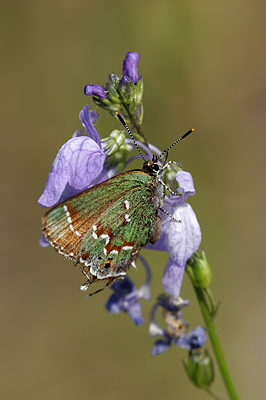|
Juniper Hairstreak (Callophrys [Mitoura] gryneus) |
 |
| County | State | Date | |||
| McCurtain | OK | 4/2005 |
|
Juniper Hairstreak (Callophrys [Mitoura] gryneus) |
 |
| County | State | Date | |||
| McCurtain | OK | 4/2005 |
Wing span: 1 - 1 1/4 inches (2.6 - 3.2 cm).
Identification: Widespread and variable. Western and eastern populations were once considered separate species but have been found to hybridize. Western: Upperside of male dull red-brown, female tawny; both with dark brown costa and wing borders. Underside of forewing rust-red; hindwing dull to bright green with irregular white line edged inwardly with red-brown. Eastern: Upperside of male dark brown with olive-colored sheen, female blackish brown. Underside green; forewing with tawny base, hindwing with 2 white spots near base and irregular white line edged inwardly with red-brown.
Life history: To seek females, males perch on host trees all day. Eggs are laid singly on tips of host plant leaves, which the caterpillars eat. Chrysalids hibernate.
Flight: In the north, one brood from May-August; in the west, one brood from March-July. Two broods in the south from February-September.
Caterpillar hosts: Redcedar: (Juniperus virginiana), and (J. scopulorum), California juniper (J. californica), Utah juniper (J. osteosperma), and perhaps others.
Adult food: Nectar from various flowers including winter cress, dogbane, common milkweed, wild carrot, shepherd's needle, butterflyweed, white sweet clover, and others.
Habitat: Old fields, bluffs, barrens, juniper and pinyon-juniper woodlands, and cedar breaks.
Range: East: New England west to Nebraska, south to Florida and Texas. West: Montana, North Dakota, and Nebraska south to southern California, Arizona, New Mexico, and Baja California.